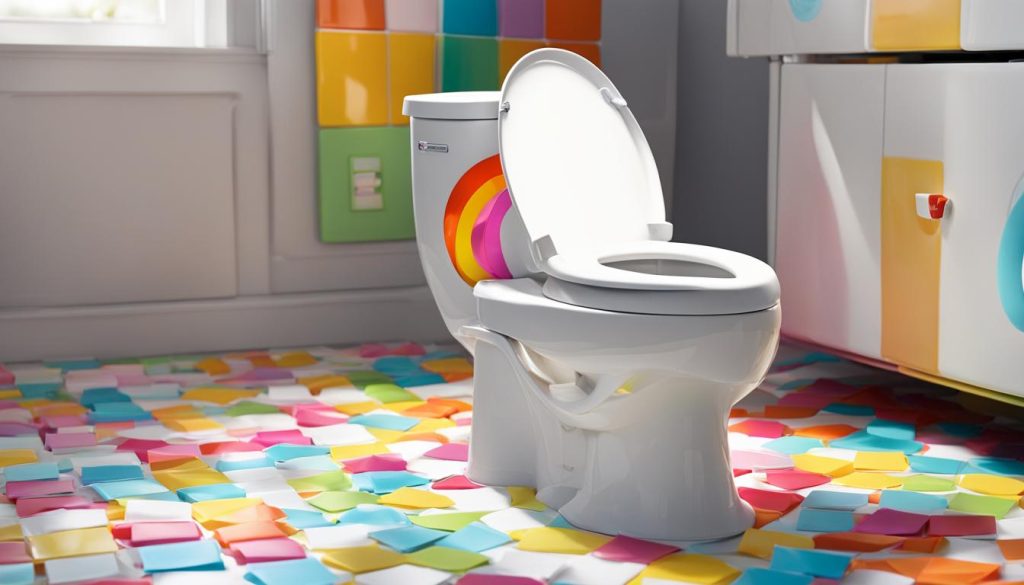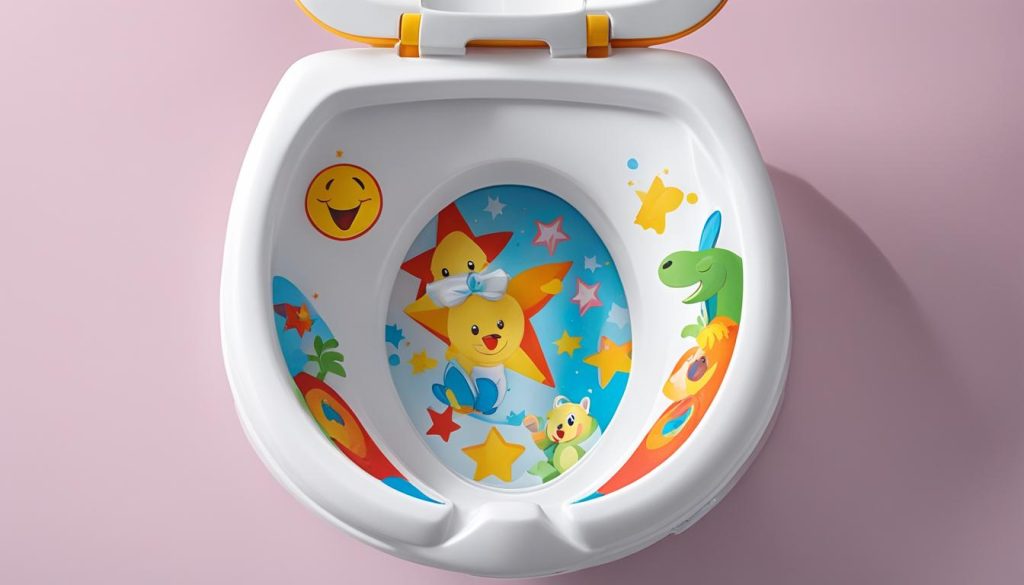Potty training is a major developmental milestone that requires patience, fortitude, and perseverance. Every child is different, and every potty training experience is unique. To make the learning phase smoother and hassle-free, there are essential potty training toilet solutions that parents can consider. These solutions include stand-alone potties, seat reducers, stools, flushable wipes, hand soap, cool potty training pants, and motivational underwear. By having the right equipment and supplies, parents can create a comfortable and safe environment for their children to learn how to use the toilet.
When it comes to toilet training, having the right tools can make all the difference. In this article, I will discuss various potty training toilet solutions that will help you navigate this important stage in your child’s development. From stand-alone potties to hygiene essentials, I will provide valuable insights and tips to ensure a successful and stress-free potty training experience for you and your toddler.
Stand-Alone Potties: Perfect Size for Little Learners
When it comes to potty training, stand-alone potties are a popular choice among parents. These kid-size potties are designed to be the perfect fit for little learners, making the transition from diapers to the toilet a little less daunting.
Stand-alone potties come in a variety of colors and designs, catering to different preferences and interests. Whether it’s a princess-themed potty or one with vibrant animal prints, these fun designs can make potty training more enjoyable for children.
One of the great advantages of stand-alone potties is their portability. Parents can place these potties in different areas of the house, making them easily accessible to children no matter where they are. This flexibility allows for seamless potty training, even when on the go.
Benefits of Stand-Alone Potties:
- Perfect size for toddlers
- Less intimidating than a traditional toilet
- Various colors and designs available
- Portable and easy to move around
Parent Testimonial:
“Having a stand-alone potty was a game-changer for us. It made potty training so much easier and less stressful. My daughter loved the colorful design and felt more comfortable using it compared to a regular toilet. Plus, I could easily move it from room to room, which was super convenient!” – Emily, mother of two
| Pros of Stand-Alone Potties | Cons of Stand-Alone Potties |
|---|---|
|
|
Seat Reducers: Child-Friendly Size on a Traditional Toilet
When it comes to potty training, seat reducers, also known as potty seats, are a game-changer. These nifty devices sit on top of a traditional toilet seat and reduce it to a child-friendly size, making it more comfortable and less intimidating for little ones. Seat reducers come in various designs and colors, often featuring beloved characters or playful patterns to appeal to children’s interests. With their secure fit and added stability, seat reducers provide a sense of safety and confidence during the potty training process.
One of the key advantages of seat reducers is that they allow children to start using the same toilet as adults. This makes the transition to independent toileting smoother and lessens the need for multiple potty training devices. Seat reducers are also easy to install and remove, making them convenient for families with shared bathrooms. They can be stored away when not in use, keeping the bathroom clutter-free.
Using a seat reducer encourages proper toilet posture, as children can sit comfortably with their feet flat on the floor. This helps them develop good habits early on and facilitates smooth bowel movements. Seat reducers are an essential tool in promoting independence and empowering children to take charge of their potty training journey.
Table: Comparing Stand-Alone Potties and Seat Reducers
| Stand-Alone Potties | Seat Reducers |
|---|---|
| Smaller size, perfect for toddlers | Child-friendly size on a traditional toilet |
| Portable and can be used anywhere in the house | Installed on the toilet, eliminating the need for a separate potty |
| May have built-in sounds or rewards for motivation | Can be personalized with fun designs and patterns |
| Require cleaning and emptying after each use | Easy to clean and maintain |
| May prolong the transition to using a regular toilet | Promote independence and facilitate using adult-sized toilets |
Whether you choose a stand-alone potty or a seat reducer, it’s important to consider your child’s preferences and needs. Some children may feel more at ease with a stand-alone potty, while others may prefer using a seat reducer to emulate adult behavior. It’s essential to create a positive and supportive environment that encourages your child’s progress, regardless of the potty training solution you choose. Remember, each child is unique, and their potty training journey should be tailored to their individual readiness and comfort level.
Stools: Safety, Stability, and Accessibility
Stools are an essential potty training toilet solution that provides safety, stability, and accessibility for children. They play a crucial role in helping young learners get up onto a seat reducer or the toilet itself, making the process more comfortable and less intimidating. Stools offer a sense of security and confidence for children, allowing them to feel supported while using the bathroom.
When selecting a stool for potty training, it’s important to choose one that is sturdy and non-slip. Look for stools with rubberized grips on the bottom to ensure stability on various surfaces. Additionally, consider stools with handrails or non-skid steps for added safety. These features provide children with the support they need to navigate the potty training process with ease.
Moreover, stools are not just useful during toilet training. They can also serve a dual purpose by assisting children in reaching the sink and faucet for handwashing. By having a stool in the bathroom, parents can promote good hygiene practices while encouraging independence in their little ones.
Hygiene Essentials: Flushable Wipes and Hand Soap
When it comes to potty training, maintaining proper hygiene is crucial. Teaching children good hygiene practices from an early age helps instill healthy habits that will last a lifetime. Two essential items for ensuring cleanliness during the potty training process are flushable wipes and hand soap.
Flushable wipes provide a convenient and effective way to clean up after using the toilet. Unlike traditional toilet tissue, flushable wipes are softer and gentler on sensitive skin. They are also safer for plumbing systems, as they break down easily when flushed. By incorporating flushable wipes into the potty training routine, parents can ensure thorough cleanliness and help prevent any discomfort or irritation.
In addition to flushable wipes, using a suitable hand soap is essential for maintaining proper hygiene. Potty training is an excellent opportunity to teach children the importance of handwashing. By choosing a hand soap with foaming properties, parents can make the process more appealing to toddlers. The fun and bubbly foam make handwashing enjoyable, encouraging children to develop a routine of washing their hands after using the toilet.
“Proper hygiene is a critical aspect of potty training. By incorporating flushable wipes and a suitable hand soap, parents can teach their children the importance of cleanliness and encourage healthy habits.”
It’s important to involve children in the hygiene routine and make it a fun and engaging experience. Encourage them to use the flushable wipes independently and show them how to lather their hands with soap to create a bubbly foam. By making hygiene enjoyable and emphasizing its significance, parents can ensure that children develop good habits early on.
| Benefits of Flushable Wipes | Benefits of Hand Soap |
|---|---|
|
|
Clothing and Accessories: Motivational Underwear and Elastic Waist Pants
In addition to the essential potty training toilet solutions, clothing and accessories can play a significant role in supporting a child’s potty training journey. Motivational underwear and elastic waist pants are two key items that can contribute to a positive and successful experience.
Motivational underwear is designed with colorful and fun patterns that appeal to children. By allowing them to choose their own favorite designs, these underwear options can create a sense of excitement and personal ownership over the potty training process. When children feel proud and enthusiastic about their underwear, it can serve as a motivating factor to use the toilet and avoid accidents.
Elastic waist pants are another valuable addition to a child’s potty training wardrobe. These pants are designed with stretchy waistbands that make it easier for children to independently pull them up and down when using the toilet. The elastic waistband allows for quick and convenient access to the toilet, promoting a sense of autonomy and self-sufficiency. It also reduces frustration and minimizes the need for adult assistance, empowering children to take control of their own potty training journey.
By incorporating motivational underwear and elastic waist pants into a child’s potty training routine, parents can provide their little ones with clothing options that support their independence and promote confidence. These small but significant additions to the potty training process can make a world of difference in the overall success and ease of toilet learning.
Conclusion
Potty training is a process that requires patience, understanding, and support from parents. By creating a comfortable and safe environment with the right potty training toilet solutions, parents can make the learning phase hassle-free for their children. Stand-alone potties, seat reducers, stools, flushable wipes, hand soap, motivational underwear, and elastic waist pants are all essential tools that can aid in the toilet training journey.
Remember that every child is unique, and it’s important to tailor the approach to their individual needs and readiness. With the right resources and guidance, parents can ensure a successful and stress-free potty training experience for their toddlers.
For more potty training tips and advice, be sure to check out our comprehensive guide on toddler toilet training. We cover everything from getting started to overcoming common challenges. Happy potty training!





